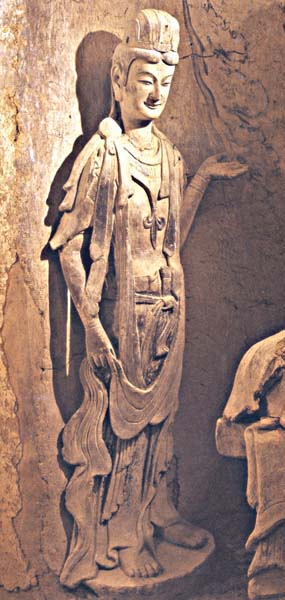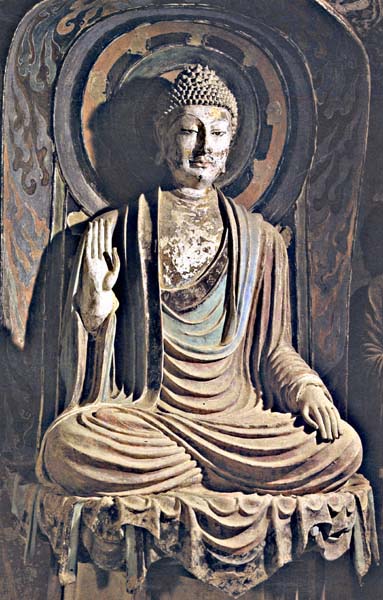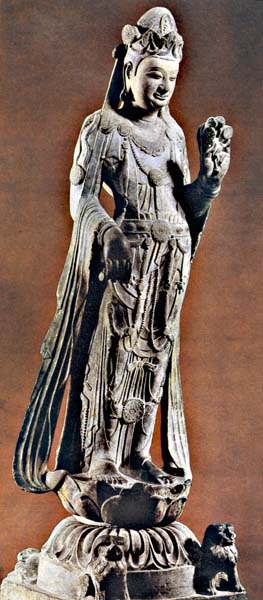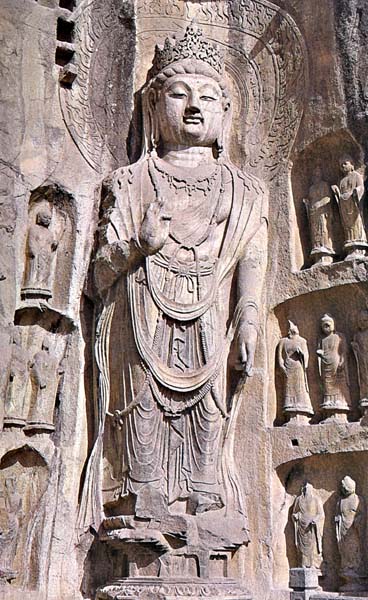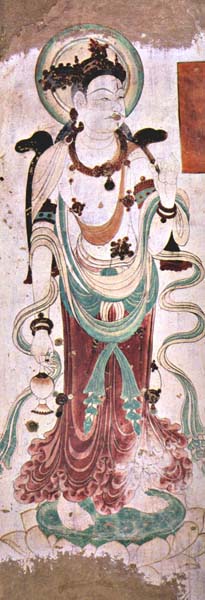
|
Bodhisattvas are enlightened beings who have put off entering paradise in order to help others attain enlightenment. There are many different Bodhisattvas, but the most famous in China is Avalokitesvara, known in Chinese as Guanyin. Bodhisattvas are usually depicted as less austere or inward than the
Buddha. Renouncing their own salvation and immediate entrance into
nirvana, they devote all their power and energy to saving suffering
beings in this world. As deities of compassion, Bodhisattvas are
typically represented with precious jewelry, elegant garments and
graceful postures. |
||||||||||
|
To the left is a clay statue from Maijishan from the Northern Wei period.
What about this figure strikes you as being markedly different from the Buddha images you've seen?
|
||||||||||
|
Clay Bodhisattva from Maijishan, 5th c Height: 142 cm (4 ft 7 in)
|
||||||||||
|
Below are two Bodhisattva stone reliefs, one (left) from Yungang and
the other (right) from Majishan (both Northern Wei period, 5th century). |
||||||||||
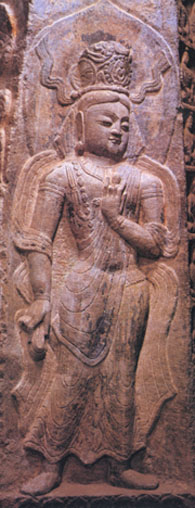 |
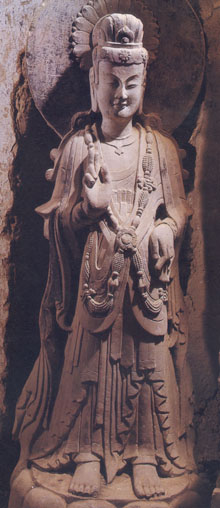
What differences between the two figures do you observe? Does one or the other seem to better represent the idea of the Bodhisattva? |
|||||||||
|
Stone relief of Bodhisattva from Yungang, 5th c. Height: 127 cm (4 ft 2 in)
|
Stone relief of Bodhisattva from Maijishan, 5th c. Height: 155 cm (5ft 1 in)
|
|||||||||
|
The Tang dynasty ushered in a period of growth and prosperity, during which Buddhism flourished. Buddhist beliefs, temples, and art permeated almost all levels of Tang life. Surviving Buddhist sculpture reflects the wealth of the great Buddhist monasteries. Many of these sculptures were decorated with rich, painted colors, which have faded with time. Try to imagine how these may have appeared when first made. Below are two Tang Bodhisattvas, both from Dunhuang. One (left) was dated back to ca. 700, the other (right) to ca. 800. |
||||||||||
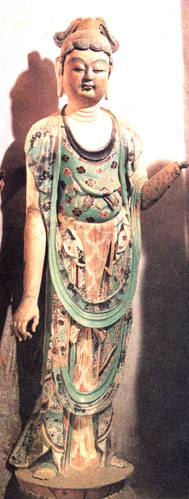 |
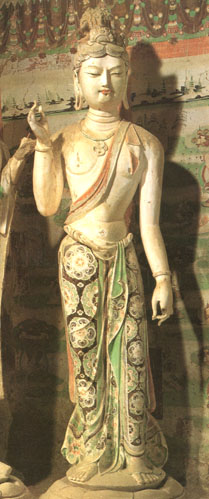
Do you remember the Tang Buddha sculpture from Dunhuang?
Do these two Tang Bodhisattvas share characteristics with the Dunhuang Tang Buddha?
|
|||||||||
|
Painted clay Bodhisattva from Dunhuang, ca. 700 Height: 143 cm (4 ft 7 in)
|
Painted clay Bodhisattva from Dunhuang, ca. 800 Height: 159 cm (5 ft 3 inch)
|
|||||||||
|
||||||||||
|
One of the Bodhisattva figures below is an early Tang example and the other is a Sui example. |
||||||||||
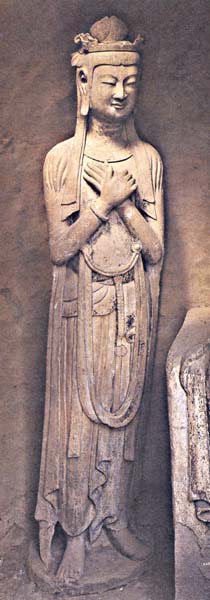 |
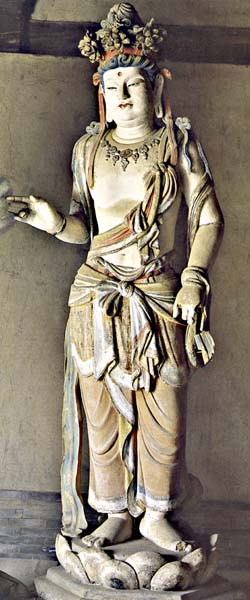
Can you tell which one is the Tang example? What helps you
identify it? |
|||||||||
|
Stone relief of Bodhisattva Height: 43 cm (1 ft 5 in)
|
Painted clay Bodhisattva Height: 258 cm (8 ft 5 in)
|
|||||||||
|
||||||||||
|
The image of Guanyin was traditionally depicted as a young Indian prince, but during the Tang the feminine characteristics of Guanyin became more prominent. To the left and below we have four Guanyin from the Sui and Tang periods. Try and see if you can follow this transformation from the images provided.
To the left is a Sui (581-618) Guanyin. |
||||||||||
Guanyin statue, ca. 600 Height: 249 cm (8 ft 2 in)
|
||||||||||
|
Below are two Tang images of Guanyin. One (left) is from Fengxian Monastery at Longmen, the other (right) from Dunhuang. Do you see the roots of Guanyin's manifestation as the Chinese Goddess of Mercy in these images? |
||||||||||
|
|
|
|||||||||
|
Stone Guanyin at Longmen Height: 13.3 cm (43 ft 7 in)
|
Wall painting of Guanyin, 8th c. Height: 190 cm (6 ft 3 in)
|
|||||||||
|
After the Tang, the cult of Guanyin grew in popularity largely due to popular literature, folk stories, and artistic images. By the sixteenth century Guanyin had become a Chinese goddess figure. In some folk religions she had become independent from her Buddhist origins. Below are two later examples of Guanyin images. The one on the left is from the Song and the one on the right is from the Ming. What makes these figures appear more feminine than the previous images of Guanyin? |
||||||||||
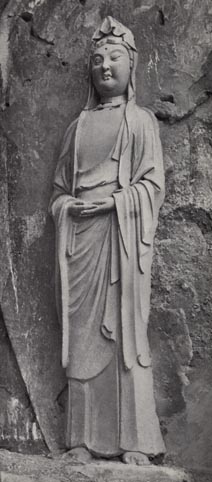
|
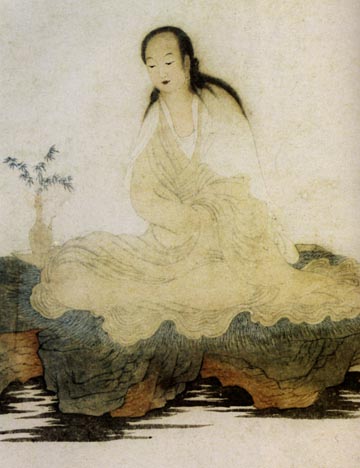 |
|||||||||
|
Song stone Guanyin from Majishan (Cave 165)
|
|
|||||||||
|
Move on to Other Divinities
|
||||||||||
